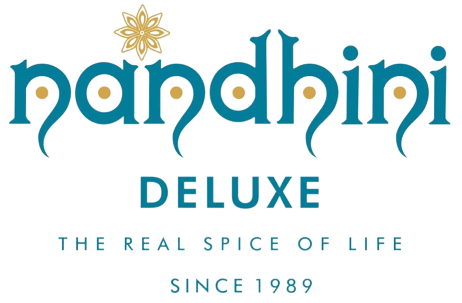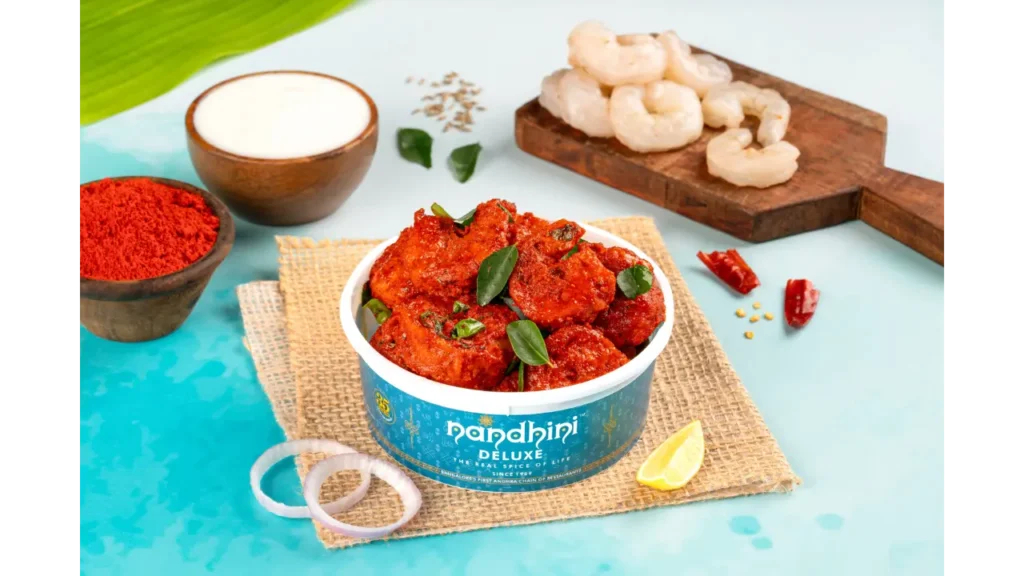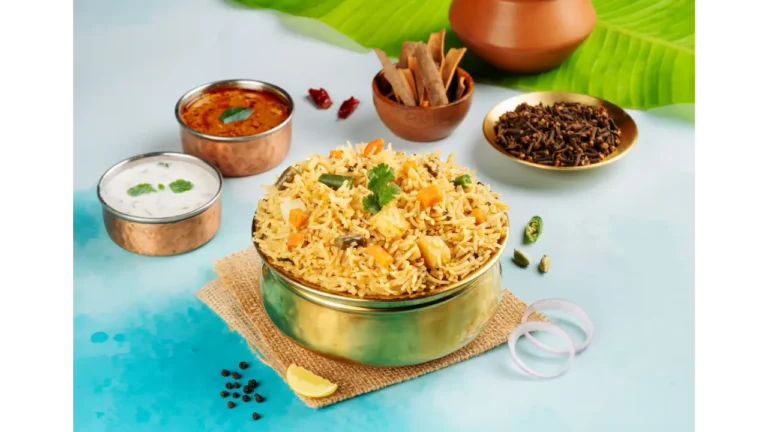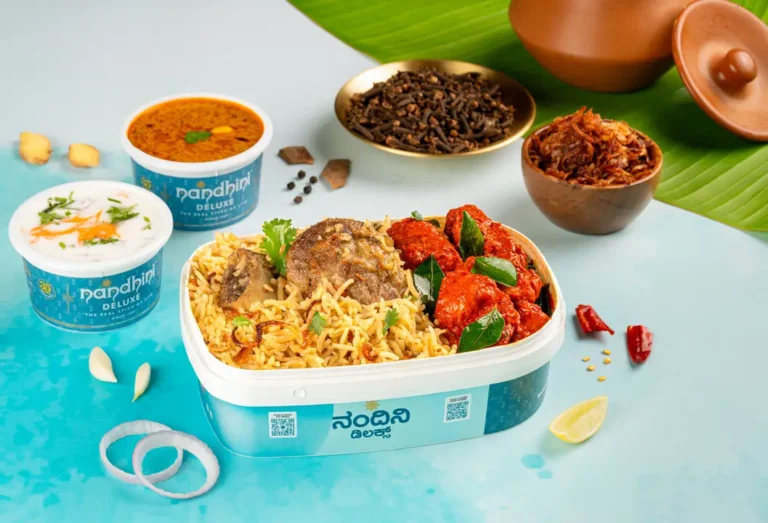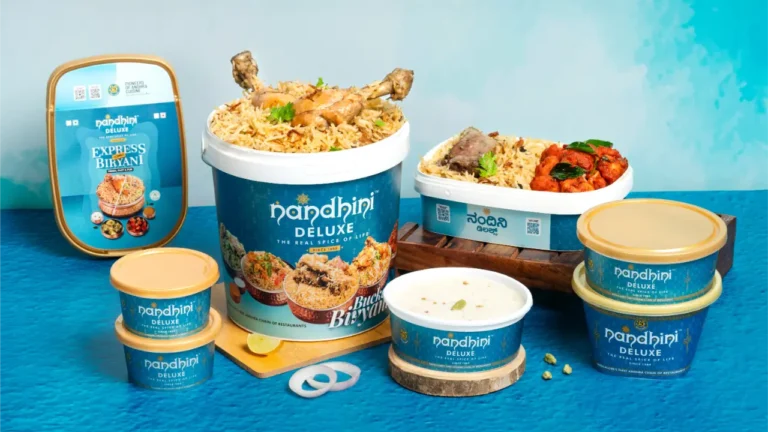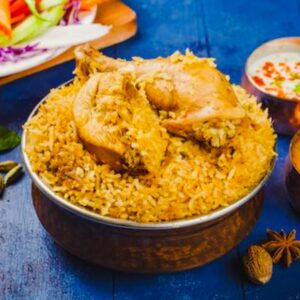Introduction
Coastal Andhra cuisine meets Bangalore with a clean, briny profile and a disciplined spice arc. Seafood takes the lead: prawns with natural sweetness, seer fish with firm flakes, and pomfret with delicate bones. These proteins sit inside a structure that pairs Guntur chilli heat with souring agents such as tamarind and gongura. Cooking media matter just as much. Clay-pot simmering builds a rounded pulusu body, while iron-tawa searing drives crust formation for fry plates. The city’s weekend rhythm amplifies this experience, since higher turnover improves freshness and widens choice.
Multi-branch operators stabilize the journey from search to plate. Nandhini Deluxe positions coastal Andhra items alongside familiar Andhra thalis, keeping spice bands predictable across MG Road lunches, Indiranagar dinners, and Koramangala late nights. A diner who orders prawn biryani on Friday and chepala pulusu on Sunday expects consistent heat logic, reliable pairing options, and service pacing that protects texture. This guide treats seafood, chillies, acids, and starches as interconnected entities. Each has attributes and behaviors; combined, they create a plate that is hot but navigable.
The result is a Bangalore-specific playbook. It shows which chilli blend preserves prawn sweetness, how tamarind body differs from gongura tang, which dishes travel safely for delivery, and when weekend specials make the most sense. With that framework, diners can map cravings to precise dishes and pairings instead of guessing from a list.
Key Takeaways
- Coastal Andhra in Bangalore = seafood-first plates with Guntur chilli and high-acid gravies.
- Teja drives sharper spikes; Sannam 334 balances color and medium-high heat for curries.
- Clay-pot pulusu vs iron-tawa fry is a texture and heat-retention decision.
- Weekends often bring better freshness and broader specials.
- Nandhini Deluxe standardizes spice bands and service pacing across key neighborhoods.
Table of Contents
What Coastal Andhra Cuisine Means in an Urban Bangalore Setting
Coastal Andhra cuisine in Bangalore is defined by seafood availability, controlled heat, and acid-forward gravies that keep bites lively. Service cues from Andhra thalis carry into seafood plates. Banana-leaf layouts reserve the top rim for pickles and podis, while rice occupies the center as a heat buffer. A ghee dot appears not as ornament but as a functional coolant, useful when chilli adhesion on fry items runs high.
Protein choice sets texture expectations. Prawns deliver snap and sweetness, thriving in vepudu and iguru where oil phases highlight spice without dulling natural sugars. Seer fish provides large, meaty flakes that hold shape in tawa fry and resist shredding in pulusu. Pomfret brings a lighter, buttery feel with fine bones that reward careful pacing. Cut style and skin presence influence outcomes: skin-on seer fry gains crisp edges and better spice retention; bone-in chepala pulusu deepens broth with collagen.
Chilli and acid determine perception. Guntur Teja produces a quick, bright spike suited to fry plates and short-reduction gravies. Sannam 334 strengthens color while smoothing the climb in long-simmer pulusu. Tamarind thickens and rounds a curry, making heat feel anchored. Gongura adds leaner, leaf-led tang that can sharpen chilli edges unless balanced with starch or dairy.
Urban context shapes timing and discovery. Office corridors near MG Road lean into fast-service thalis with seafood add-ons at lunch. Indiranagar’s evening crowds prefer shared plates and steady parking. Koramangala often pushes later hours and delivery; crisp-fry survival and leak-proof pulusu packaging become decisive. Standardized execution from multi-branch restaurants such as Nandhini Deluxe reduces uncertainty across these scenarios, giving diners repeatable spice bands, reliable gravies, and predictable pairings that fit Bangalore’s daily rhythm.
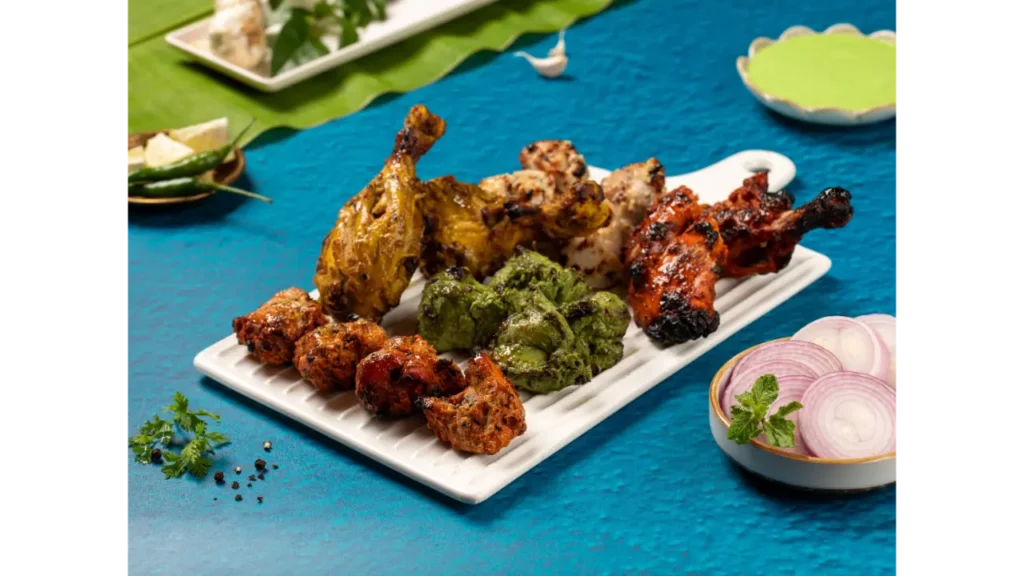
The Seafood Playbook
Seafood in coastal Andhra cooking responds to preparation choices with clear, observable signals. Prawns act as efficient carriers for spice because surface area and light fat content allow rubs to bind quickly. Deshelling timing matters. A brief sear with shell on locks moisture and preserves sweetness; final deshelling before toss-in-spice prevents overcooking. Curl index indicates doneness: tight C-shape signals ready; a full O suggests overshoot.
Fish cuts drive method. Seer fillets favor iron-tawa searing with medium granularity rubs that fuse into a thin crust. Excessively coarse chilli powders detach during turning, while ultra-fine pastes steam the surface. Bone-in chepala suits clay pots where collagen enriches the pulusu and stabilizes spice bloom. Pomfret benefits from shallow-fry or gentle tawa treatment to protect delicate muscle fibers.
Cooking media sets heat trajectory. Kadai vepudu concentrates the oil phase and intensifies capsaicin, creating longer burn time per bite. Clay-pot simmering distributes heat slowly, letting Sannam 334 develop color and a rounder finish. Quick iguru reductions land between the two: more body than a fry, more immediacy than a pulusu.
Seasoning logic ties it together. Teja-led blends bring crisp spikes to vepudu and tawa fry. Sannam-forward mixes keep gravies vivid without eclipsing seafood aroma. Salt staging is critical: early salting on prawns risks purge; late-stage seasoning with a controlled toss keeps texture intact. Lemon is a final-mile tool, not a marinade stand-in for fish fry; application at the table preserves crust and wakes aroma.
Pairings close the loop. Rice and ragi sangati provide volume control for hot gravies. Perugu and majjiga offer casein-based relief for oil-heavy plates. For mixed-tolerance tables, a shared order plan works: one fry for intensity, one pulusu for body, and a cooling side on standby. This playbook translates cravings into predictable results, aligning spice, texture, and comfort across busy Bangalore dining windows.
Chilli Varieties and Blends for Seafood
Chilli choice frames taste, color, and burn time in coastal Andhra seafood. Guntur Teja sits at the hot end with quick, bright impact. Small quantities lift vepudu and tawa fry immediately, keeping prawn sweetness intact when heat is applied in short bursts. Teja’s fine grind integrates with oil, forming a uniform film that adheres to shells or skin-on fillets, which is why crusts stay lively even after a squeeze of lemon.
Sannam 334 occupies medium-high heat with stronger color delivery. Long-simmer gravies such as chepala pulusu benefit from Sannam because it releases pigment steadily while avoiding a harsh spike. In clay pots, this cultivar builds a rounded finish that supports tamarind’s body without smothering fish aroma. When gravies need visibility on the plate and predictable warmth across a long service window, Sannam carries the shift.
Blends solve real kitchen problems. A Teja-led blend with a Sannam backline delivers both definition and hue for royyala iguru, where quick reduction demands fast flavor plus visible red. Adding a measured Byadgi fraction introduces aroma and stable color at gentler heat, useful when cooking delicate pomfret that cannot handle aggressive spice. Grind size matters as much as cultivar. Medium granularity improves grip on fish rubs; superfine powders risk caking and steaming, especially on tawa surfaces.
Salt, fat, and timing round out the matrix. Early salting on prawns drives moisture loss that dilutes spice. Late-stage salt with a splash of hot oil reactivates aromatics without breaking textures. For diners gauging heat, think in bands, not numbers. Teja suits short, hot profiles. Sannam secures medium-high warmth and plate appeal in gravies. Byadgi modulates perfume and color. The blend that reaches the table reflects a clear goal: retain seafood character while presenting the signature Andhra red that signals appetite and intent.
Signature Dishes Decoded
Chepala pulusu is the benchmark for coastal Andhra gravies. Bone-in cuts simmer in tamarind-forward sauce colored by Sannam 334. Collagen enriches the body, creating a smooth glide with medium-high heat. Best practice pairs modest ladles with rice, adding ghee only if a sharper chilli edge appears. A cucumber-onion side returns freshness between bites without disrupting the sauce.
Royyala vepudu and iguru showcase oil-phase intensity. In vepudu, prawns meet a Teja-led rub, hit high heat briefly, then finish with a spice toss that clings to surface proteins. Burn time extends because oil retains capsaicin near the palate. Iguru lands between fry and curry. Reduction concentrates aromatics into a glossy coat that reads hot but not harsh, making it a reliable center plate for groups.
Seer fish tawa fry is a study in crust management. Fillets receive a medium-grind rub, rest briefly, then sear on an iron surface until edges crisp and the center stays succulent. Salt enters late to prevent purge. Lemon appears at the table to wake aroma without softening the crust. A small curd spoon beside the plate acts as a reset when heat creeps.
Prawn biryani links seafood sweetness to a controlled chilli arc. Stock depth matters more than sheer spice. Kitchens often use a Teja accent for definition and a Sannam base for color stability, finishing with fried onions and a restrained ghee trail. Raita supports comfort without washing out perfume. For diners choosing across the table, a balanced order might read as chepala pulusu for body, seer fry for crunch, and prawn biryani for breadth, with curd and ghee positioned as responsive tools rather than afterthoughts. This decoder turns a list of names into predictable textures, heat bands, and pairing moves that deliver satisfaction on schedule.
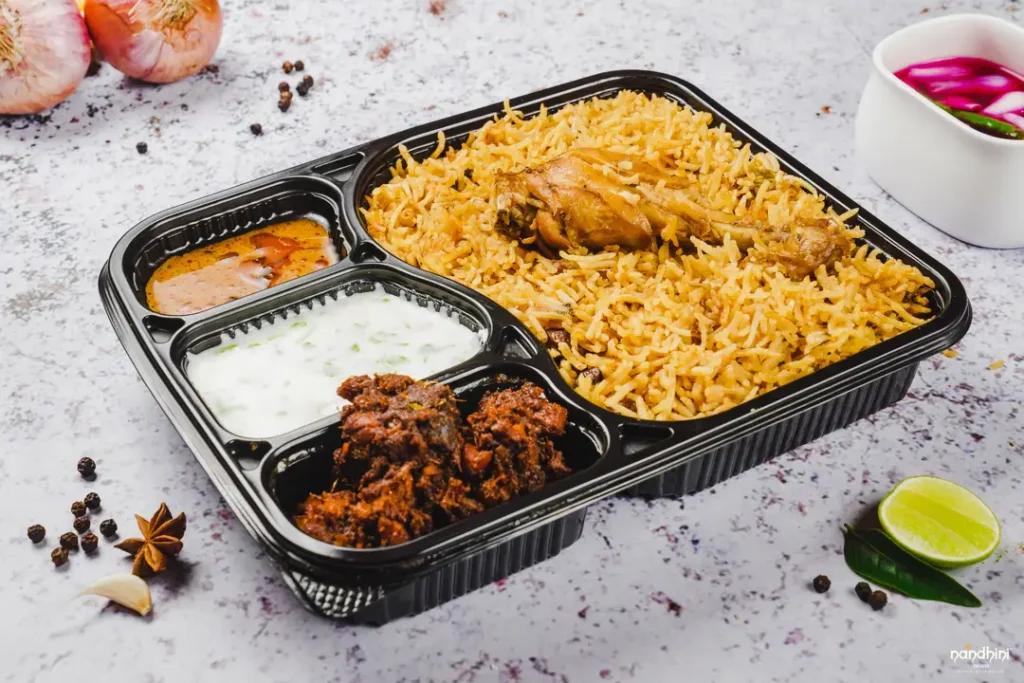
The Bangalore Coastal Heat Map for Seafood
Heat in coastal Andhra seafood behaves consistently when broken into dish-level bands. The chilli cultivar, cooking medium, and fat content together determine whether a dish feels mild, hot, or somewhere between.
Prawn biryani typically sits in the medium-high band. A Teja-heavy blend creates a sharper spike, while Sannam 334 softens the climb and builds strong color in the rice. The sweetness of prawns prevents the burn from dominating, making this a reliable order for mixed-tolerance tables.
Chepala pulusu is more sustained. Tamarind’s body and Sannam’s gradual heat combine to form a long, even burn that lingers. Collagen from bone-in fish thickens the sauce, ensuring capsaicin clings to rice grains for each bite. The effect is steady, not searing, but persists until countered by ghee or curd.
Royyala vepudu occupies the high end of the heat ladder. Oil-rich surfaces trap Teja’s compounds and keep them in contact with the palate longer than broth-based dishes. Burn time extends two to three minutes per bite, best moderated with buttermilk or starch buffers.
Seer fish tawa fry lands in the hot band but fades faster than vepudu because surface crisping reduces oil saturation. A late squeeze of lemon brightens flavor while avoiding extended burn.
Pickles and pachadis push into very hot territory in concentrated micro-doses. They are not meant for bulk consumption but for sharp spikes that reset the palate or lift neutral rice.
Viewed as a matrix, medium dishes fade quickly, hot plates linger longer, and very hot condiments strike fast. Sequencing them in an order—rice and pulusu first, fry items mid-meal, pickles last—creates a balanced curve that satisfies spice seekers without overwhelming others at the table.
Cooling Pairings That Protect Flavor
Coastal Andhra seafood requires pairings that temper heat without flattening flavor. Ghee works first. A small dot folded into rice dissolves capsaicin in fat, softening sharp edges and preserving the aroma of tamarind or gongura. It is the most immediate reset for pulusu.
Dairy provides sustained relief. Perugu mixed into rice or majjiga sipped between fry bites introduces casein, which binds capsaicin molecules and clears the receptors. For oil-heavy vepudu, dairy is essential because water-based solutions cannot cut through the fat layer.
Starch volume controls intensity. A spoon of rice or ragi sangati stretches hot gravies across a neutral base. Ragi adds earthy weight that reduces spikes more than plain rice.
Acidity plays a dual role. Lemon on fried fish lifts aroma without altering heat perception, but excessive lime in gravies can sharpen burn. Acid should brighten, not rescue.
Sweet finishes like jaggery or payasam close the arc. Their viscosity cools late-stage burn while signaling meal completion. Fresh cucumber-onion salads add crunch and water content, offering sensory relief even when not chemically strong.
The matrix is sequential: ghee for immediate balance, curd or buttermilk for sustained comfort, starch for dilution, and selective acid for contrast. Diners who follow this logic can enjoy hot seafood plates fully, managing intensity while retaining coastal Andhra’s distinctive flavor clarity.
FAQs
Q: Is coastal Andhra seafood always very spicy in Bangalore
A: Heat varies by cultivar and method. Teja-led fries run hot. Sannam-based pulusu lands medium-high with steadier warmth.
Q: Which fish cut holds up best in delivery
A: Seer fillets and prawn biryani travel well. Medium-thick pulusu ships safely in tight containers with raita on the side.
Q: Tamarind or gongura for fish curry
A: Tamarind gives rounded body and stable heat. Gongura adds lean tang and can feel sharper unless paired with starch or curd.
Q: Best pairing to manage a hot royyala vepudu
A: Start with rice and a small ghee fold, then add curd or buttermilk between bites for sustained relief.
Q: When should lemon be added to seer fish tawa fry
A: At the table after the first bites. This preserves crust while lifting aroma without lengthening burn.
Q: Can spice be tuned without changing the recipe
A: Many kitchens provide extra ghee, curd, or buttermilk on request, lowering perceived heat while keeping flavors intact.
Conclusion
Coastal Andhra cuisine in Bangalore thrives on clear patterns: seafood freshness, disciplined chilli use, and acid-led gravies that stay bright from first bite to last. Prawns, seer fish, and pomfret respond differently to heat and cooking media, so dish choice determines both texture and burn time. Teja supplies quick, vivid spikes for fry plates. Sannam 334 sustains color and warmth in clay-pot pulusu. Tamarind rounds a sauce; gongura sharpens it. Ghee and dairy act as reliable stabilizers, while rice or ragi sangati manage intensity without muting aroma.
Weekend service often widens variety and improves texture due to faster turnover, making it the best window for platters and special cuts. Neighborhood patterns matter as well: CBD for swift thali-plus-seafood lunches, Indiranagar for shared dinners, Koramangala for late orders and delivery. Multi-branch consistency from operators such as Nandhini Deluxe reduces guesswork on spice bands, doneness, and pairing options, turning intent into predictable satisfaction. With the seafood playbook, heat map, and pairing matrix in hand, diners can match cravings to specific dishes and enjoy coastal Andhra flavors at their best in Bangalore.
